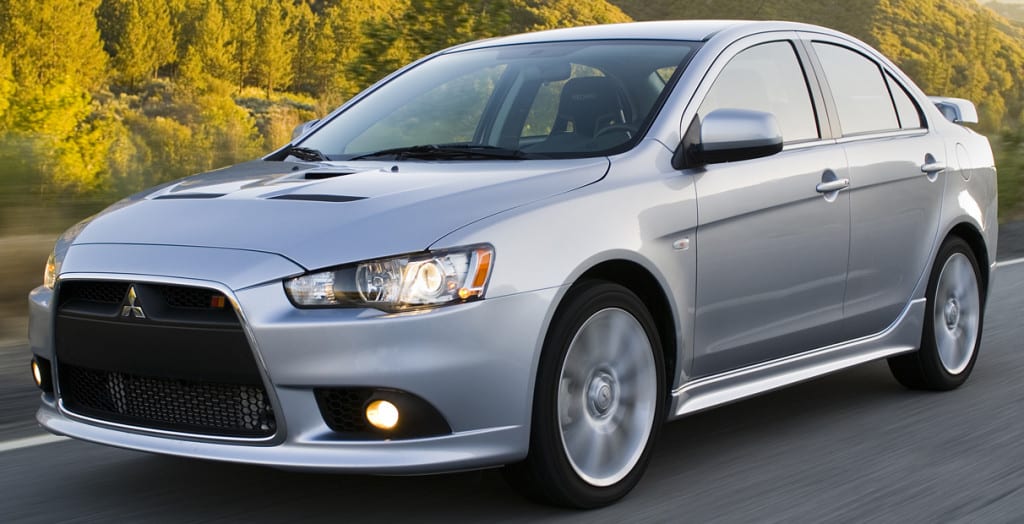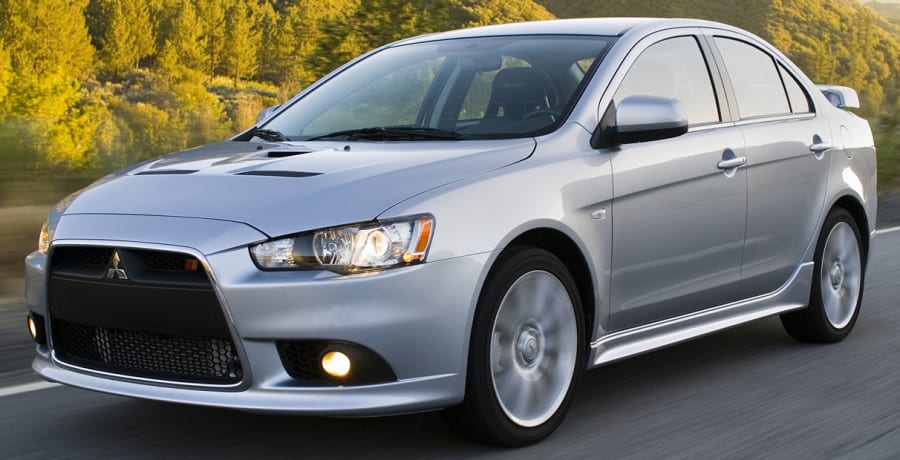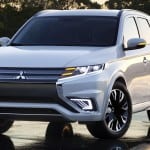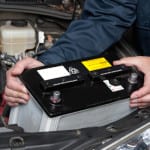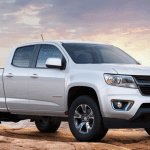Over the years, Mitsubishi has produced many models that have seen intense popularity both in the states and worldwide.
The lineup you see at your Mitsubishi dealer is drawn from a strong background in racing and a history of advanced technology development. Here’s a look at how some of Mitsubishi’s most memorable vehicles came to life and led the market.
Lancer
The Mitsubishi Lancer has been around since 1973, though it has been known by a myriad of names and has gone through nine generational changes up to today.
Sold in various countries, it has held monikers including Colt Lancer, Eagle Summit, and Mitsubishi Mirage. By the late 2000s, Mitsubishi reported that over 6 million Lancers had been sold worldwide.
It was originally designed to round out the lineup, falling under the larger Galant in size, but fitting in above the Minica, a popular model sold by Mitsubishi in Japan.
The Lancer originally came in four different body-styles: a two-door, a four-door, a hardtop coupe, and a five-door station wagon. Several engine options were available including 1.2, 1.4, and 1.6-liter four-cylinders.
The 1600 GSR model was the car that kicked off Mitsubishi’s longstanding racing history. It won the Safari Rally twice and the Southern Cross Rally four times.
However the Mitsu that Americans know as the Lancer today did not hit the scene until much later. It arrived in 2002, taking over for the previous Mirage sedan.
Available in three different trim levels, including the sporty O-Z Rally trim, the Lancer offered consumers a snazzy-looking exterior and a number of interior features.
It was powered by a 2.0-liter engine paired with a five-speed manual transmission, and it delivered 120 horsepower. By 2004, it was clear that the Lancer’s sporty nature was a big draw for buyers, so Mitsubishi decided to up the ante.
They introduced a Ralliart trim with a larger 2.4-liter engine that pumped out 162 horsepower. It also came with alloy wheels, a sport-tuned suspension, and an enhanced exhaust system.
They also came out with a Sportback wagon that had the same amount of horsepower. However, it came standard with a four-speed automatic which was typically optional on other trims. It was short-lived and went out of production only two years later.
For 2008, the next generation Lancer arrived with a 152-horsepower 2.0-liter DOHC engine. An all-new CVT transmission was also available. In the years to come, the ES Sport trim was added and another Sportback was briefly produced.
Today, the Lancer is offered in ES, SE, GT, and Ralliart trims with engine options ranging from a 2.0-liter MIVEC with 148 horsepower to a turbocharged version with 237-horsepower.
The Lancer comes with a long list of standard and available convenience and safety features. In fact, it has been one of the IIHS’ Top Safety Picks for the past seven years.
And with its paddle shifters, 18-inch alloy wheels, and full-time AWD with mode selection, the Lancer Ralliart has become one of the best and most affordable cars available for enthusiasts.
Evo
The Lancer Evolution (Evo) is a high performance version of the Lancer that was originally intended only for sale in Japan. However, Mitsubishi began marketing it in Europe after Evos made their way there through various unofficial channels.
By 2003, the manufacturer also made the decision to bring their sought after sports car to America after seeing how much success Subaru was having with their Impreza WRX STi.
It didn’t take long for the Evo to catch on as the go-to vehicle for adrenaline junkies. By the time it hit American dealerships, the souped up Lancer was already in its eighth generation.
It sported impressive 17-inch Enkei wheels, Brembo brakes and Bilstein shocks, and a 2.0-liter engine that furnished 271 horsepower. It was capable of hitting 100 miles per hour in just 5.1 seconds.
The Evo saw such rapid popularity that by 2005, four different trims were available. In addition to its race-ready specs, buyers could also get features like sunroofs, subwoofers, and leather seats.
Currently, the renowned Lancer Evo upholds its reputation for speed and swagger. Upgraded to 291 horsepower, the turbocharged sports car comes with Super All-Wheel Control and an available Twin Clutch Sportronic Shift Transmission, making it highly responsive.
Sadly, 2015 will be the final year of production for this beloved Mitsu, and fans have been scrambling to get their hands on the last models.
Mitsubishi will be releasing the Special Action Model later this year as a final farewell, and it promises to be pumped full of even more ponies and drool-worthy performance equipment.
Eclipse
The Eclipse was Mitsubishi’s answer to the American desire for reasonably priced sports cars. Their chic coupe went into production just in time for the ’90s and was even offered as a convertible in ’96.
The car drew its name from and English racehorse that won 26 races in its competition days. The first generation was advertised as an entry to mid-level sports coupe with a plethora of options depending on how much buyers were willing to spend.
It came standard as a FWD vehicle but higher trim levels included AWD. Models from the highest tiers also came with turbocharged engines to spice things up. The turbo version appeared on Car and Driver’s Ten Best List for 1989-1992.
In its second generation, the Eclipse saw some styling revisions to keep it up to date, and the convertible Spyder made its debut.
Another makeover came in 1997, when the Eclipse was given a slightly more aggressive look with a new front grille, more angular lights, and a sleek black interior.
The third generation received a more intense slew of updates based on a concept that Mitsubishi had brought to the North American Auto Show in 1998.
Two engine options became the standard offering. They were a 2.4-liter 4-cylinder with 147 horsepower and a 205-horsepower 3.0-liter V6. AWD was removed as an option, and a new suspension was put in place to offer a smoother, softer ride.
And in its fourth generation, which began in 2006, engine options delivered up to 265 horsepower. Styling also evolved during the final six years of the Eclipse’s production, and luxury packages with plush interiors and premium features continued to be offered.
2012 marked the Eclipse’s final model year, but the last one was actually built in August of 2011. The very last Eclipse had a special Kalapana Black finish that was chosen by Facebook fans.
It was also equipped with the commemorative SE package and a slew of other one-of-a-kind details. It was auctioned off for charity, marking the end of the Eclipse’s extremely successful run.
Mirage
The Mitsubishi Mirage, which has reappeared as part of the lineup today, actually began production way back in 1978. The first four generations of the car were sold through Chrysler thanks to Mitsu’s close partnership with the company.
However, its history is a difficult one to follow due to the use of various names in various countries. Many versions were sold as Lancers though the unrelated Lancer model was also sold in the U.S.
The entry-level three-door hatchback was introduced as a direct response to the oil crisis of 1978. Consumers were looking for smaller cars with better fuel economy, and Mitsu made the affordable Mirage the perfect answer.
Throughout the ’80s and ’90s, a series of variations were offered by both Mitsubishi and Chrysler. The Mirage was offered as a hatch and sedan. And the Dodge and Plymouth Colt were sold as rebadged versions of the vehicle.
The Mirage sedans saw varying success, especially after the release of the Eclipse, which attracted many buyers. That was further evidence of America’s preference for sportier models.
The Mirage was replaced by the Lancer in the early 2000s and did not return until 2012 when Mitsubishi brought it back as a sharp-looking, fuel-efficient hatchback.
Mitsu’s latest incarnation of the Mirage has received high praise for its low price sticker, comprehensive features, and outstanding fuel economy.
IHS Automotive even recognized it for having the Highest Model Loyalty in its segment. And it’s no wonder. The 2015 model starts at just under $13K and gets up to 44 miles per gallon.
3000GT
The 3000GT was produced for just over a decade and was the product of a collaboration between Mitsubishi in Chrysler. In the U.S. it was sold as both the 3000GT and the Dodge Stealth.
It was based on Mitsubishi’s HSX concept and went on to become the manufacturer’s flagship model in Japan. Though it was called the GTO in Japan, there was concern about using the name in other countries which were familiar with models like the Ferrari GTO and Porsche GTO.
It was a highly advanced car that incorporated lots of Mitsu’s latest technologies including full-time AWD, electronically controlled suspension, and active aerodynamics.
As costs increased over the years, some of those systems were dropped in favor of including more standard staples like the latest safety features.
By 1996, Chrysler had discontinued the Dodge Stealth and only the 3000GT was still for sale in the U.S. In ’95 and ’96, a special edition convertible model, the 3000GT Spyder, was also sold.
But by the end of the ’90s, sports car sales in American had seen a significant decrease and Mitsubishi knew it was time for the 3000GT to make its exit. The last year it was available was 1999, with Japanese sales wrapping up in 2000.
